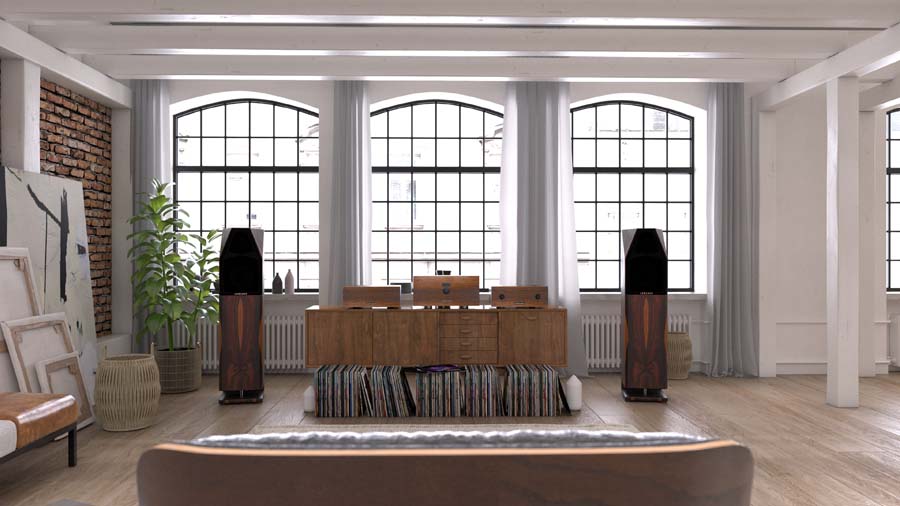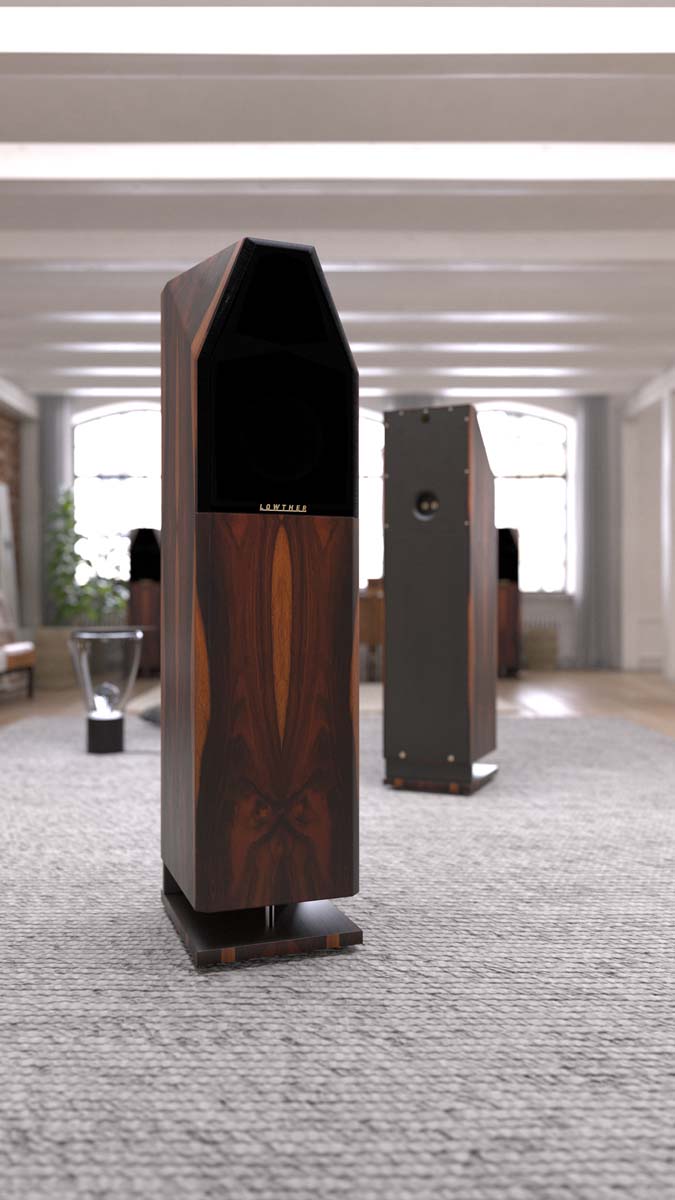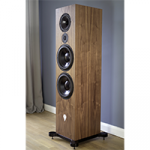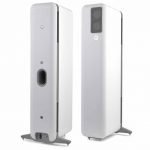LOWTHER ALMIRA LOUDSPEAKERS REVIEW
Lowther Almira is the latest loudspeaker from the well-known and well-loved British manufacturer. In this review, Janine takes a listen to these £12,000 wide-band speakers (£14,500 in the rosewood finish shown).

Beautiful finish on this Rosewood version of the Almira. Note the supertweeter above the wideband driver.
Lowther was one of those companies I always wanted to review; noted for the manufacture of single full-range drivers and very large horn-loaded cabinets. I have had a varying opinion of Lowther over the years; some speakers sounding great and others not quite so. Perhaps the differences were due to the differing quality of the listening rooms at HiFi shows, plus some disappointment due to the roll-off above 10k. So, to try one out in my own house was something I really wanted to do. The new Almira marks a change from the usual Lowther lineup, though, as it also includes a super-tweeter taking those frequencies well above 20K. It is also “small” by their standards, with a floor area of 300 x 330mm and height of around 1200mm.
Lowther started up in 1934, a company initially making amplifiers and tuners. Mr Lowther soon realised he needed speakers to add to the “radiogram” type cabinets and chose Voigt full range corner speaker cabinets. These were able to hit 10kHz, which was a very good response in those days, but Voigt soon discovered that by adding a whizzer cone, the frequency response could be raised further still. British born, though with German parents, Paul Voigt had studied Engineering at University College London before he went on to work at the Edison Bell Works in London. His ideas on loudspeakers led him to set up his own company where he soon met O.P Lowther, and which began a pairing that would last many years. Indeed, both Lowther and Voigt combined to set up Lowther-Voigt Radio at one point. Paul was unfortunate in that despite all his amazing work in the UK he was discriminated against and forced to emigrate to Canada after WW2 because of his German name and parents. When he moved there he left all his cabinet designs in the capable hands of Lowther.
After several changes of management and rebirths, Lowther finally shut its doors in August 2018. At that stage, they were only making a few drivers. Two months later the company was bought by Martin Thornton who had been introduced to the shareholders via a friend of his who happened to be a supplier to Lowthers. Despite having little knowledge of HiFi, having previously run a company as a supplier to the rail industry, he was attracted to the brand and purchased the equity and all assets of Lowthers. All employees were re-employed and they continued manufacturing at workshops near Downham Market, Norfolk. This ensured the retention of skills.

Being a horn-loaded design the Lowther Alira are a large loudspeaker, but not huge.
“Having acquired the business” Martin told me “I did a lot more research into the Lowther brand and its history. It became very attractive to me. I sought assistance and background from several Lowther enthusiasts and a number of their previous customers”.
Lowther soon began exploring the re-manufacturing of cabinets which had ceased 15 years earlier. A relationship was established with Northampton based Malcolm Williamson, a high-quality cabinet manufacturer, whose skills even included making violins, and with a passion for quality music. He subsequently became a shareholder in Lowthers. That cabinet, in Australian Gum Walnut supplied for this review, was one of the best quality I have seen and looked amazing in my living room. Peter Snell, also based in Northampton, joined to assist in developing an online marketing campaign designed to re-establish the Lowther brand. Now with offices based in Northampton, the company is re-making some of the Lowther favourites from yesteryear, plus the all-new Almira at around £12,000 (Rosewood, limited to 10 pairs, for approximately £14,500/pair).
But why call it the Almira? When Jimi Hendrix moved into Handel’s house in Brook Street, London, his HiFi included Lowther Acousta 115s. Inspired by Lowther’s recent restoration of them for the Handel-Hendrix museum, they decided to call their first completely new speaker for many years after the principal character in Handel’s first opera; “Almira”. That sounds much better than calling it after Hendrix’s “Foxy Lady” or “The Wind Cries Mary”, I guess.
DESIGN STRATEGY
The Lowther strategy has always been to use a single paper full frequency cone, in this case the DX3 with neodymium magnets and a foam surround. I remember the original PM4A in my youth and Lowther is continuing to produce this, along with PM2A/3A/5A/6A, and EX and DX variants, and various sound diffusers and phase compensators screwed in on the front of the drivers. Cabinets are horn-loaded, following the work of Paul Voigt. In this case, it is a 2.3m single folded quarter-wave generic Voigt horn pattern, with floor facing exit. It was also Voigt who introduced the full frequency cone using a whizzer at the front creating a mechanical crossover. The whizzer cone enabled the speaker to deliver high frequencies, and the bass relied on the main cone feeding back into the internal horn loading of the cabinet. When Voigt released them, people were amazed at the realistic room-filling sound. The first Voigt corner horn in 1934 sold for £32.50. I wasn’t to be disappointed by the “room-filling” sound in my own living room, with excellent bass and treble extension due to the super-tweeter that was quite astounding. I was quite surprised at just how high a frequency I was still able to hear at my age!
The Almira cabinet is beautifully shaped at the sides, toeing in at the top with no parallel sides and no curves. The choice of Rosewood, Olive, Australian Gum Walnut and Zebrano take it beyond the standard cabinetry, and the unit sits on 4 feet. Even the inside is meticulously assembled. Instead of tilting fillets to approximate the bends, each change of direction is manifest using laminated curves and composite plywood and foam divisions to allow the air in the pipe to “see” a smooth and constant expansion. A bit like streamlining a car body in order to increase its efficiency. Positioning the DX3 motor at a specific point in the pipe length creates a natural high-pass cut off frequency. This means that virtually no interior wadding is necessary.

The Almira has an interesting shape to its cabinet.
Finally, and a first, a 20mm dome supertweeter is placed close to the top of the unit above the DX3. Interestingly, this driver is recessed well into the unit with a tapered horn in front, so that it lies behind that of the DX3. The unit is made in-house and follows the same construction and materials as the cone and whizzer in the full-range drivers. There is no 2-way crossover employed, the tweeter continues from where the DX3 drops off. The tweeter is protected by a high-quality capacitor and sloped in from around 8kHz 6dB/octave. Interestingly in listening to the unit, I was highly impressed with the overall frequency graph, and all sound emanating very musically from a single point source, rather than two different positions. Things were getting better with every second I played music. This was not an optimistic fairytale, the quality of sound and build showed that Martin and his colleagues had done their homework and were producing both audio and visual magic. The bass extension was superb and the top-end was pin-sharp, showing the super-tweeter was bringing new life into the music. That said, the 8” DX3 itself had a reasonable top-end, rolling off rapidly from around 10kHz but quoted as going all the way to 22kHz. Interestingly, Lowther is presently looking at making a three-way variant of this model using the DX45 and DX2 with a Hemp cone. Other new and historical products in varying sizes are also in production, and a range of new products including amp, DAC and phonostage are promised down the line. Under new management, they want to concentrate on all of the good qualities of Lowthers but are endeavouring to improve the poor elements that Lowther had acquired in the past.
“We are currently testing with replacements for our foam surrounds, new paper cones, new back centre design, superior quality solder and improved voice coils”.
I take my hat off to them.
SOUND
Listening to the Almira was quite a shock to me; these are highly efficient speakers meaning I needed to reduce my Music First Audio preamplifier to the lowest setting I have ever used for a review. These have around 98dB/1W sensitivity, so it’s best to turn the sound right down when you switch on, because if your amplifiers have a “thud” when they start up, you could damage the fragile drivers.
I expected to hear a boxy sound when listening but was so surprised at the flat response. I also found the top-end clarity superb extending the audio further than many speakers I have reviewed.
Listening first with digital sources did give me differing results; some music I played was absolutely amazing, but other music just sounded more “digital” than I wanted. “Dance on a Volcano” (48/24 FLAC) had an excellent top-end but it sounded more tizzy than I was used to. These speakers hide nothing; any discrepancies and they will show them. The bass was amazing, though. The cellist could be heard moving about before he started to play and then during the playing the sympathetic vibrations of the instrument itself were audible. These speakers were growing on me every minute I played them.
As the supertweeter is horn-loaded the sound is more revealing and directional, so an ideal sitting position is vital. These are very directional speakers. That said, the positioning of the large cabinet wasn’t as critical as I expected it would be. I placed it 12” away from walls and units and it sounded fine. Playing Rene Aubry’s “Amnesie” let out a “wow” from me every time I heard the bass “bursts” in the music which appeared at the start of each phrase. These sounded more like subwoofers! Only the piano playing was a little too rounded off for my complete enjoyment. “Come Fly With Me” from the Amsterdam Jazz Trio had all frequencies covered with equal ferocity and this time the piano sounded perfect. The ride cymbals were very accurately placed in the soundfield making for a very accurate and enjoyable playing – this time a CD played on a Krell KPS20i.
So far, the music worked well on easy listening music – so time to turn up the wick with some progressive rock from Yes and the album ‘Fragile’. There was plenty of pace and space, plus excellent detail, especially from the acoustic guitar at the start. Only at times did I find the performance “confused”. This wasn’t a fault of the speakers – or the musicians – because turning to my vinyl version of the same album things were a lot better. No, this was down to the digits; on an analogue source, things were markedly better; the detail and stereo spread was just as I imagined it to be. The distorted guitar on the right channel at one point was the same on FLAC as it was on vinyl, but just more obvious on the former. These are revealing speakers and as such deserve the very best sources you can partner them with. Be careful not to use too powerful amplifiers, though; the all-valve Synthesis is just under 100W which was fine. My CD player sounded great, but I found some of my FLACs didn’t perform well on the Almira. Good analogue recordings on the other hand were no problem. Indeed, Engineer Malcolm Williamson designed the speakers around analogue and red-book digits, and consequently, this really showed in my playing.

With their drivers covered.
Turning to classics and Britten’s Four Sea Interludes (Vernon Handley, Ulster Orchestra) did give me an excellent musical adaptation of the composer’s life in Lowestoft. This 48/24 FLAC recording had excellent power when it needed it and elegance in the quieter sections. Strings were detailed and gave shape and space to the soundstage. Music was clear not just left and right, but also having a good vertical account. Chasing the Dragon’s ‘Big Band Spectacular’ was … spectacular. Excellent clarity and power from the brass section and space when needed. These speakers were not difficult to drive and the music was as I expected to hear. Brass works well, just as strings in all the classical listening I did. This is an all-round performer.
Final listening was an album my sister bought me when I was a child, and one I have treasured and listened to ever since; Andrew Lloyd Webber ‘Variations’, based on the Theme and Variations from violinist Paganini. Other composers have written “versions” of this work, notably Rachmaninov. This work has everything from cello (Julian L Webber), keyboards (Rod Argent), drums/percussion, wind, bass, guitar etc, so a good test for this speaker. The main reason I chose it was because the tracks can “shout” at times in the mid and top frequencies, as could older Lowthers, and so I wanted to see how this fragile paper driver could cope. Again, I was impressed. There was an excellent controlled bass from the very start. This speaker could seriously move air. The Lowther also controlled the cymbals better than many speakers I have had the fortune to review. The sound was very accurate, almost electrostatic at times, only a few times a little to forward in the midrange.
CONCLUSION
I didn’t expect to be as excited about a horn-loaded, single-driver speaker as this, but I was really impressed at the full frequency response and power. This is no pipe and slippers box like some Lowther’s from the 50’s. This looks truly 21st century and sounds just as present-day when placed carefully in any medium-sized living room. With the addition of the supertweeter that top-end anemia is cured, with music performance even extended for bats.
The bass was similarly extended downwards and well controlled giving the listener a great degree of involvement in whatever you throw at it. £12,000 might not sound cheap, but if you have an amplifier that can do it some good, preferably valve in my opinion, then this is a great partnership.
AT A GLANCE
Build Quality:
Excellent build quality with a good choice of veneers
Sound Quality:
Extended but well-controlled bass and super top end
Value For Money:
£12,000 is not cheap, but the build quality alone makes it good value
We Loved:
Excellent transients
Top-end clarity
Bass extension
No crossover needed
We didn’t Love So Much:
Careful with some digital music
Price: £12,000 as tested (£14,500 in Rosewood in images)
Elevator Pitch Review: Having heard Lowther speakers at HiFi shows in the ’90s, I was sceptical about doing this review; I had always found them hard, grainy and a bit boxy. But under new management I was in for a big, big surprise. This is not what I expected. Not only was the build quality superb, but it played all types of music with equal passion and power. The top-end now includes a supertweeter to take the sound further than even my Townshend could go and that DX3 driver, combined with the ¼ wave horn loading, was enough to wake up my neighbours.

Janine Elliot
Review Equipment:
Synthesis Roma 98DC (KT88 power amp) Krell KAV250a (S/S power amp), Music First Audio Baby Reference (pre-amp); Pre-Audio (turntable)/AT33sa (cartridge)/Manley Steelhead (Phono-stage); Krell KPS20i (CD), FLACs and DSD via Astell and Kern SE180 DAP/ iFi streamer; Tellurium Q, Ecosse and Townshend (cables).

SPECIFICATION
Sensitivity: around 98dB/watt
Nominal Impedance: 8 Ohm
Dimensions: 300w x 320d x 1200h mm
Rated 100W















































































































































































